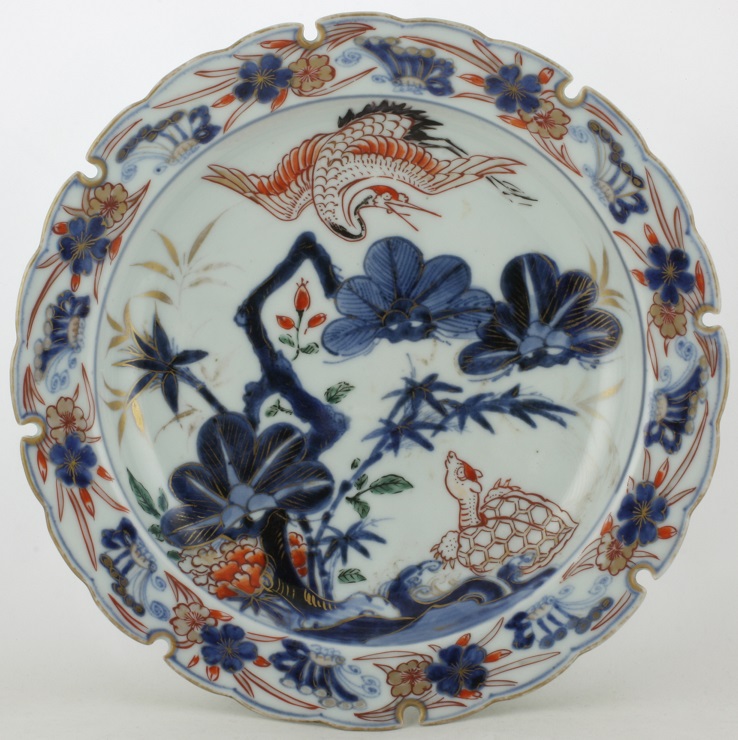
Sold Ceramics - Sold Japanese Imari 1690-1800 - Dishes - Page 1
Object 2012026
Dish
Japan
1730-1750
Height 41 mm (1.61 inch), diameter 245 mm (9.65 inch), diameter of footring 130 mm (5.12 inch), weight 586 grams (20.67 ounce (oz.))
Dish on footring with a spreading flat scalloped rim and eight recesses to the edge. On the base five spur-marks in a X-pattern. Imari decorated in underglaze blue, iron-red and gold with a crane in flight just above a pine tree and various plants growing near a shore with a tortoise rising up from out of the water. On the rim a butterfly alternating with flower sprays. On the reverse three flower sprays.
On Japanese ceramics the tortoise is often depicted in combination with the crane (Q.V.), the design known as tsuru to kame. This combination is emblematic of good fortune and happiness. It refers to a famous legend in which two lovers eventually changed into a crane and tortoise and journeyed together to the realm of the Immortals. The tortoise shell motif is one of the oldest decorative motifs in Japanese art. (Arts 1983, p.118)
The crane (tsuru), the tortoise (minogame), the pine tree (matsu) and the butterfly (chõ-chõ) are all symbols of longevity.
Ten different forms of tortoise are said to exist, the chief of all being the divine tortoise (shin kame), conceived by thought and attaining an age of thousand years or more. At the age of 500 years certain plants would grow upon its shell, which, streaming backwards as it swims about, would give it the well-known appearance of a long-haired tortoise, also known as the 'raincoat' tortoise (minogame), because its resemblance to a peasant's straw raincoat. The Japanese say that the tortoise has inscribed on his back the roku-jõ (six cardinal virtues) namely: chi (wisdom), yú (friendship), gi (fidelity), jin (charity), shin (sincerity) and kan (contemplation), an old idea borrowed from the Chinese. (Arts 1983, p.117)
The shape of this dish is that of a snow flake roundel, (yukiwa-gate). A European influence could very well be possible as the border is not dissimilar to that of Monteith bowls. These dishes come in various sizes and were produced for export most likely by the Higuchi kiln and the Hokaoyama kiln. Usually the Higuchi kiln examples tend to be of poorer quality porcelain than the Hokaoyama examples, but the pattern seems closer to those from the Higuchi kiln. (I am indebted to Mr. T. Coram for this information)
Identical dishes are in the Kyushu Ceramic Museum, the Usui Collection and in an English private collection.
For an identically shaped and decorated (larger 280 mm (11.02 inch)) dish, please see;
One occasionally finds bowls with this form, for an example, please see:
Condition: Some wear to the green enamel.
References:
Price: Sold.


 create websites
create websites